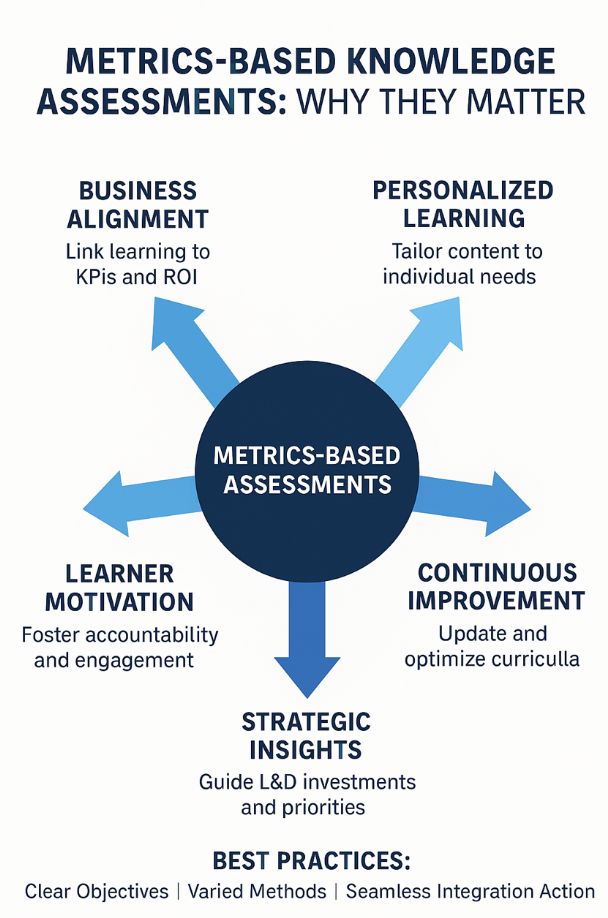Metrics-based Assessments Why do they matter?
Kim Deene - May 12, 2025
In today’s fast-paced business environment, organizations must ensure that employee learning is not just happening, it must also be effective, targeted, and aligned with business objectives. Corporate curriculum design is no longer simply about delivering content; it’s about creating measurable impact. At the heart of this shift lies the use of metrics-based knowledge assessments, a critical tool that informs and drives modern learning and development (L&D) strategies.
Why Does it Matter?
Metrics-based knowledge assessments provide tangible data on learner performance, comprehension, and retention. Without them, curriculum design is largely guesswork, relying on subjective perceptions rather than objective evidence. Metrics give instructional designers and L&D teams insights into how well employees are mastering required skills and where knowledge gaps exist.
In short, if it can be measured, it can be improved, both in the short term and over time.
Enhancing Personalization and Adaptability
Metrics-based knowledge assessments also enable a more personalized learning experience. By continuously collecting data on individual learner performance, organizations can tailor content to meet learners where they are, offering remediation where necessary and advanced content where appropriate. This adaptability ensures that training time is used efficiently and that employees are not overwhelmed or under-challenged.
In addition, adaptive curriculum design powered by real-time assessment data fosters a culture of continuous learning, which is vital in industries where skills evolve rapidly.
Driving Continuous Improvement
A static curriculum quickly becomes obsolete. Metrics-based assessments create a feedback loop that allows for the continuous improvement of learning materials. When assessment results reveal widespread misunderstandings or repeated failures in particular content areas, it signals the need for curriculum updates, instructional redesign, or even a reevaluation of delivery methods.
This data-driven refinement process keeps corporate training relevant, engaging, and effective over time.
Fostering Accountability and Motivation
Transparent assessments help foster learner accountability. Employees are more motivated to engage with the material when they understand that their progress is being measured and that those measures tie into their professional development and advancement.
Additionally, team leaders and managers can use assessment data to coach their teams more effectively, identifying high performers, mentoring those who need extra support, and creating a targeted development scope.
Best Practices for Implementing Metrics-Based Assessments
To maximize the benefits, organizations should consider the following best practices:
Set Clear Learning Objectives: Define what success looks like before designing assessments. Complete a needs analysis and determine an appropriate cut-score, using your SMEs (subject matter experts), guiding them through an assessment validation meeting.
Use a Variety of Assessment Methods: Combine quizzes, shadow time, on-the-job-training, and performance tasks for a fuller picture of learning.
Ensure Fairness and Validity: Assessments should accurately measure the knowledge and skills they intend to, without cultural or systemic biases.
Integrate Assessments Seamlessly: Embed them naturally into the learning experience to avoid disrupting engagement.
Analyze and Act on Data: Use assessment outcomes to drive decision-making around curriculum design, delivery, and evaluation.
Conclusion
Incorporating metrics-based knowledge assessments into corporate curriculum design is not just a best practice, it’s a necessity for organizations that want to thrive and have success across teams. These assessments provide the evidence needed to validate learning efforts, align education with business outcomes, and adapt rapidly to changing skill requirements. By committing to a data-driven approach, companies can ensure that their investment in learning and development delivers real, measurable value.
Metrics-Based Knowledge Assessments: Why they matter
——-
Kim Deene has spent over 15 years in the world of Learning & Development, turning complex challenges into clear, engaging learning solutions. With a background in music education and a knack for bringing structure to chaos, she blends creativity, strategy, and data to design training that actually works. Kim is passionate about making learning meaningful—and measuring what matters along the way.
You can reach Kim through LInkedIn here

